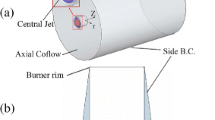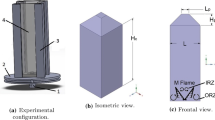Abstract
Flame stabilization is the key to extending scramjets to hypersonic speeds; accordingly, this topic has attracted much attention in theoretical research and engineering design. This study performed large eddy simulations (LESs) of lifted hydrogen jet combustion in a stepped-wall combustor, focusing on the flame stabilization mechanisms, especially for the autoignition effect. An assumed probability density function (PDF) approach was used to close the subgrid chemical reaction source. The reliability of the solver was confirmed by comparing the LES results with experimental data and published simulated results. The hydrogen jet and the incoming stream were first mixed by entraining large-scale vortices in the shear layer, and stable combustion in the near-wall region was achieved downstream of the flame induction region. The autoignition cascade is a transition of fuel-rich flame to stoichiometric ratio flame that plays a role in forming the flame base, which subsequently causes downstream flame stabilization. Three cases with different jet total temperatures are compared, and the results show that the increase in the total temperature reduces the lift-off distance of the flame. In the highest total temperature case, an excessively large scalar dissipation rate inhibits the autoignition cascade, resulting in a fuel-rich low-temperature flame.
概 要
目 的
深入理解超声速条件下火焰稳定机制, 为超燃冲压发动机燃烧室的优化提供理论基础.
创新点
1. 通过大涡模拟准确地再现Burrows-Kurkov实验中台阶壁面射流燃烧室的反应流场; 2. 揭示射流火焰稳定抬举的机制; 3. 总结射流总温对火焰抬举特性的影响.
方 法
1. 采用大涡模拟, 获得了瞬时和时均的反应流场参数; 2. 通过计算燃烧学的数据分析, 提取湍流火焰特性.
结 论
1. 自点火过程维持了混合层中抬举火焰的稳定, 并进一步在下游形成充分发展的湍流扩散火焰; 2. 升高射流总温会使火焰抬举高度降低, 而过高的射流总温会抑制火焰温度的升高.
Similar content being viewed by others
References
Baurle RA, Hsu AT, Hassan HA, 1995. Assumed and evolution probability density functions in supersonic turbulent combustion calculations. Journal of Propulsion and Power, 11(6):1132–1138. https://doi.org/10.2514/3.23951
Boivin P, Dauptain A, Jiménez C, et al., 2012. Simulation of a supersonic hydrogen-air autoignition-stabilized flame using reduced chemistry. Combustion and Flame, 159(4): 1779–1790. https://doi.org/10.1016/j.combustflame.2011.12.012
Bouheraoua L, Domingo P, Ribert G, 2017. Large-eddy simulation of a supersonic lifted jet flame: analysis of the turbulent flame base. Combustion and Flame, 179:199–218. https://doi.org/10.1016/j.combustflame.2017.01.020
Burrows MC, Kurkov AP, 1973. An analytical and experimental study of supersonic combustion of hydrogen in vitiated air stream. AIAA Journal, 11(9):1217–1218. https://doi.org/10.2514/3.50564
Cheng T, Wehrmeyer J, Pitz R, et al., 1991. Finite-rate chemistry effects in a Mach 2 reacting flow. 27th Joint Propulsion Conference.
Chung SH, 2007. Stabilization, propagation and instability of tribrachial triple flames. Proceedings of the Combustion Institute, 31(1):877–892. https://doi.org/10.1016/j.proci.2006.08.117
Clark RJ, Bade Shrestha SO, 2013. Review of numerical modeling and simulation results pertaining to high-speed combustion in scramjets. Proceedings of the 49th AIAA/ASME/SAE/ASEE Joint Propulsion Conference, p.3724. https://doi.org/10.2514/6.2013-3724
Edwards JR, Boles JA, Baurle RA, 2012. Large-eddy/Reynolds-averaged Navier-Stokes simulation of a supersonic reacting wall jet. Combustion and Flame, 159(3): 1127–1138. https://doi.org/10.1016/j.combustflame.2011.10.009
Engblom W, Frate F, Nelson C, 2005. Progress in validation of Wind-US for ramjet/scramjet combustion. 43rd AIAA Aerospace Sciences Meeting and Exhibit. https://doi.org/10.2514/6.2005-1000
Förster H, Sattelmayer T, 2008. Validity of an assumed PDF combustion model For SCRAMJET applications. 15th AIAA International Space Planes and Hypersonic Systems and Technologies Conference. https://doi.org/10.2514/6.2008-2585
Frankel SH, Hassan HA, Drummond JP, 1990. A hybrid Reynolds averaged/PDF closure model for supersonic turbulent combustion. 21st Fluid Dynamics, Plasma Dynamics and Lasers Conference. https://doi.org/10.2514/6.1990-1573
Garnier E, Adams N, Sagaut P, 2009. Large Eddy Simulation for Compressible Flows. Springer, Dordrecht, the Netherlands. https://doi.org/10.1007/978-90-481-2819-8
Jachimowski CJ, 1988. An Analytical Study of the Hydrogenair Reaction Mechanism with Application to Scramjet Combustion. National Technical Information Service, Springfield, Virginia, USA.
Jameson A., 1991. Time dependent calculations using multigrid, with applications to unsteady flows past airfoils and wings. 10th Computational Fluid Dynamics Conference.
Karami S, Hawkes ER, Talei M, et al., 2015. Mechanisms of flame stabilisation at low lifted height in a turbulent lifted slot-jet flame. Journal of Fluid Mechanics, 777:633–689. https://doi.org/10.1017/jfm.2015.334
Lawn CJ, 2009. Lifted flames on fuel jets in co-flowing air. Progress in Energy and Combustion Science, 35(1):1–30. https://doi.org/10.1016/j.pecs.2008.06.003
Liu CY, Wang ZG, Wang HB, et al., 2016. Mixing characteristics of a transverse jet injection into supersonic crossflows through an expansion wall. Acta Astronautica, 129: 161–173. https://doi.org/10.1016/j.actaastro.2016.09.003
Liu CY, Wang ZG, Wang HB, et al., 2017. Large eddy simulation of cavity-stabilized hydrogen combustion in a diverging supersonic combustor. International Journal of Hydrogen Energy, 42(48):28918–28931. https://doi.org/10.1016/j.ijhydene.2017.09.179
Liu CY, Wang ZG, Sun MB, et al., 2019. Characteristics of a cavity-stabilized hydrogen jet flame in a model scramjet combustor. AIAA Journal, 57(4):1624–1635. https://doi.org/10.2514/1.J057346
Mastorakos E, 2009. Ignition of turbulent non-premixed flames. Progress in Energy and Combustion Science, 35(1):57–97. https://doi.org/10.1016/j.pecs.2008.07.002
Miake-Lye RC, Hammer JA, 1989. Lifted turbulent jet flames: a stability criterion based on the jet large-scale structure. Symposium (International) on Combustion, 22(1):817–824. https://doi.org/10.1016/S0082-0784(89)80091-8
Moule Y, Sabelnikov V, Mura A, 2014. Highly resolved numerical simulation of combustion in supersonic hydrogen-air coflowing jets. Combustion and Flame, 161(10): 2647–2668. https://doi.org/10.1016/j.combustflame.2014.04.011
O’brien EE, 1980. The probability density function (pdf) approach to reacting turbulent flows. In: Libby PA, Williams FA (Eds.), Turbulent Reacting Flows. Springer, Berlin, Germany, p.185–218. https://doi.org/10.1007/3540101926_11
Pitsch H, Desjardins O, Balarac G, et al., 2008. Large-eddy simulation of turbulent reacting flows. Progress in Aerospace Sciences, 44(6):466–478. https://doi.org/10.1016/j.paerosci.2008.06.005
Star J, Edwards J, Smart M, et al., 2006. Investigation of scramjet flow path stability in a shock tunnel. 36th AIAA Fluid Dynamics Conference and Exhibit.
Sun MB, Wang ZG, Liang JH, et al., 2008. Flame characteristics in supersonic combustor with hydrogen injection upstream of cavity flameholder. Journal of Propulsion and Power, 24(4):688–696. https://doi.org/10.2514/1.34970
Vyasaprasath K, Oh S, Kim KS, et al., 2015. Numerical studies of supersonic planar mixing and turbulent combustion using a detached eddy simulation (DES) model. International Journal of Aeronautical and Space Sciences, 16(4):560–570. https://doi.org/10.5139/IJASS.2015.16.4.560
Wang HB, Sun MB, Wu HY, et al., 2010. Investigation of dual time-step approach for supersonic combustion flow. Journal of National University of Defense Technology, 32(3):1–6 (in Chinese). https://doi.org/10.3969/j.issn.1001-2486.2010.03.001
Wang HB, Qin N, Sun MB, et al., 2011. A hybrid LES (large eddy simulation)/assumed sub-grid PDF (probability density function) model for supersonic turbulent combustion. Science China Technological Sciences, 54(10): 2694. https://doi.org/10.1007/s11431-011-4518-6
Wang HB, Wang ZG, Sun MB, et al., 2013. Combustion characteristics in a supersonic combustor with hydrogen injection upstream of cavity flameholder. Proceedings of the Combustion Institute, 34(2):2073–2082. https://doi.org/10.1016/j.proci.2012.06.049
Wang HB, Wang ZG, Sun MB, et al., 2014. Numerical study on supersonic mixing and combustion with hydrogen injection upstream of a cavity flameholder. Heat and Mass Transfer, 50(2):211–223. https://doi.org/10.1007/s00231-013-1227-7
Watson KA, Lyons KM, Donbar JM, et al., 2003. On scalar dissipation and partially premixed flame propagation. Combustion Science and Technology, 175(4):649–664. https://doi.org/10.1080/00102200302393
Yoon S, Jameson A, 1988. Lower-upper symmetric-Gauss-Seidel method for the Euler and Navier-Stokes equations. AIAA Journal, 26(9):1025–1026. https://doi.org/10.2514/3.10007
Yoshizawa A, Horiuti K, 1985. A statistically-derived subgrid-scale kinetic energy model for the large-eddy simulation of turbulent flows. Journal of the Physical Society of Japan, 54(8):2834–2839. https://doi.org/10.1143/JPSJ.54.2834
Author information
Authors and Affiliations
Contributions
Chao-yang LIU provided the conceptualization and developed the numerical simulation codes. Jin-cheng ZHANG executed the research process and formal analysis, and wrote and revised the manuscript. Hong-bo WANG revised the manuscript and assisted analysis. Ming-bo SUN provided the funding acquisition and resources. Zhen-guo WANG took responsibility for the research.
Corresponding author
Ethics declarations
Jin-cheng ZHANG, Ming-bo SUN, Zhen-guo WANG, Hong-bo WANG, and Chao-yang LIU declare that they have no conflict of interest.
Additional information
Project supported by the National Natural Science Foundation of China (Nos. 91741205 and 11522222)
Rights and permissions
About this article
Cite this article
Zhang, Jc., Sun, Mb., Wang, Zg. et al. Stabilization mechanisms of lifted flames in a supersonic stepped-wall jet combustor. J. Zhejiang Univ. Sci. A 22, 314–330 (2021). https://doi.org/10.1631/jzus.A2000087
Received:
Accepted:
Published:
Issue Date:
DOI: https://doi.org/10.1631/jzus.A2000087
Key words
- Large eddy simulation (LES)
- Autoignition
- Lifted flame
- Flame stabilization
- Assumed probability density function (PDF)




